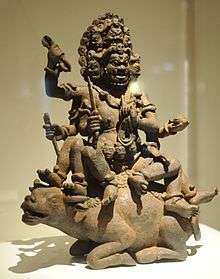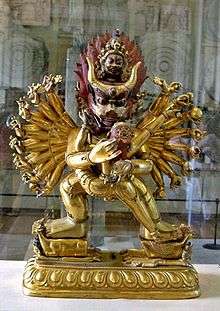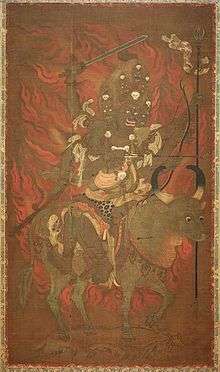Yamantaka

Yamāntaka (Sanskrit: यमान्तक Yamāntaka or Vajrabhairava Tibetan: གཤིན་རྗེ་གཤེད་, རྡོ་རྗེ་འཇིགས་བྱེད།, Wylie: gshin rje gshed; rdo rje 'jigs byed ; Korean: 대위덕명왕 DaeWiDeokMyeongWang; Japanese: 大威徳明王 Daitokumyōō; simplified Chinese: 大威德金刚; traditional Chinese: 大威德金剛; pinyin: Dà Wēidé Jīngāng; Mongolian: Эрлэгийн Жаргагчи Erlig-jin Jarghagchi) is the "lord of death" deity of Vajrayana Buddhism.[1] Sometimes he is conceptualized as "conqueror of death".[2] He belongs of the Anuttarayoga Tantra class popular deity within the Gelug school of Tibetan Buddhism.
Outline

Yamāntaka is a wrathful expression of Mañjuśrī, the Samyaksambuddha of wisdom who, in other contexts, also functions as a dharmapala or a Heruka. Yamāntaka manifests in several different forms, one of which (via yogatantra) has six legs, six faces and six arms holding various weapons while sitting or standing on a water buffalo.
Within Buddhism, "terminating death" is a quality of all buddhas as they have stopped the cycle of rebirth, samsara. Yamantaka, then, represents the goal of the Mahayana practitioner's journey to enlightenment, or the journey itself: in awakening, one adopts the practice of Yamāntaka – the practice of terminating death.
In Hinduism, Yama (Sanskrit: यम), is the lord of death. In the Rigveda, he is mentioned as one who helped humankind find a place to dwell, and gave every individual the power to tread any path to which he or she wants. In Vedic tradition, Yama was considered to be the first mortal who died and espied the way to the celestial abodes; thus, as a result, he became the ruler of the departed.[citation needed] Yama's name can be interpreted to mean "twin", and in some myths he is paired with a twin sister Yami. He also has two twin brothers, Ashvini Kumaras.
Yama is associated with various roles in Hinduism that are not always consistent throughout the stories. Sometimes, he is the lord of justice and is associated with Dharma, such as in the Brahma Purana; in other Puranas, Yama has no association with Dharma at all. .
Yama is also found in Buddhist texts. The Buddhist Yama, however, has developed different myths.
Yamantaka in Japanese Buddhism
In Japanese esoteric teachings, Dai Itoku-Myoo is the wrathful emanation of Amida and is pictured with six faces, legs and arms holding various weapons while sitting on a white ox.[3]
Gallery
 The Japanese equivalent, Daiitoku myōō.
The Japanese equivalent, Daiitoku myōō. Yamantaka-Vajrabhairava mandala
Yamantaka-Vajrabhairava mandala Yamantaka in a Beijing Buddhist temple.
Yamantaka in a Beijing Buddhist temple.
Etymology
- ↑ John Whalen-Bridge; Gary Storhoff (2009). Emergence of Buddhist American Literature, The. State University of New York Press. p. 170. ISBN 978-1-4384-2659-4.
- ↑
- ↑ Coulter, Charles Russell; Turner, Patricia (2013). Encyclopedia of Ancient Deities. Routledge. p. 140. ISBN 9781135963903.
Yamāntaka is a Sanskrit name that can be broken down into two primary elements: Yama, the name of the god of death; and antaka (making an end).[1] Thus, Yamāntaka means “Destroyer of Death” or "Conqueror of Death".[2][3]
See also
Bibliography
- Gonsalez, David (2011). The Roar of Thunder: Yamantaka Practice and Commentary. Snow Lion Publications. ISBN 978-1-55939-387-4.
- Ra Yeshé Sengé (2015). The All-Pervading Melodious Drumbeat: The Life of Ra Lotsawa. Translated with introduction and notes by Bryan J. Cuevas. Penguin Classics.
External links
- Daïitoku
- Vajrabhairava (Yamantaka) practice support
- Wrathful Guardians of Buddhism - Aesthetics and Mythology
- Yamantaka org
| Wikimedia Commons has media related to Yamantaka. |
- ↑ Monier-Williams (1899). A Sanskrit-English dictionary: Etymologically and philologically arranged with special reference to Cognate indo-european languages. Oxford: The Clarendon Press
- ↑ Buswell, Robert Jr; Lopez, Donald S. Jr., eds. (2013). Princeton Dictionary of Buddhism (Yamantaka). Princeton, NJ: Princeton University Press. p. 1020. ISBN 9780691157863.
- ↑ Getty, Alice (1914). The gods of northern Buddhism], their history, iconography, and progressive evolution through the northern Buddhist countries. Oxford: The Clarendon press. pp. 145–146.
- ↑ Dallapiccola, Anna L. (2002). "Kalarimurti; Kalaharamurti or Kalantakamurti". Dictionary of Hindu Lore and Legend. London: Thames and Hudson Ltd. ISBN 0-500-51088-1. Retrieved 16 May 2011.